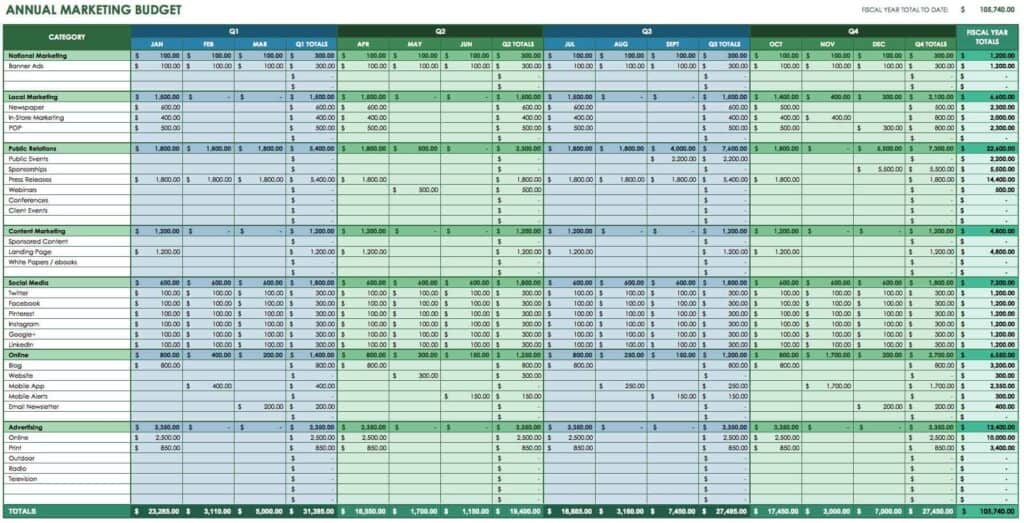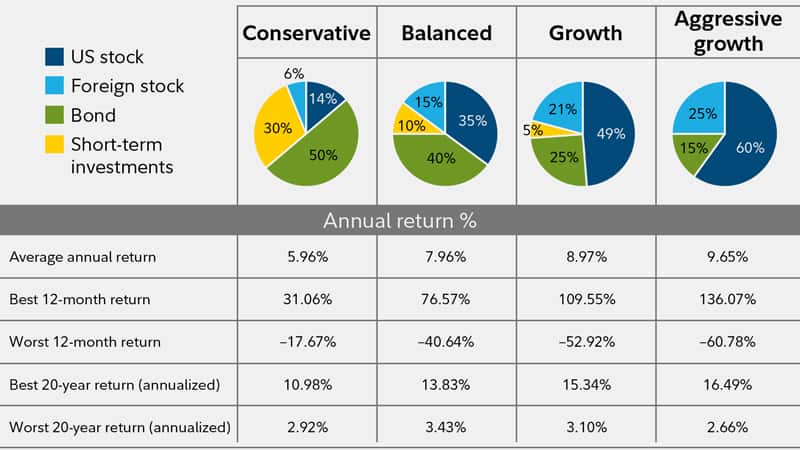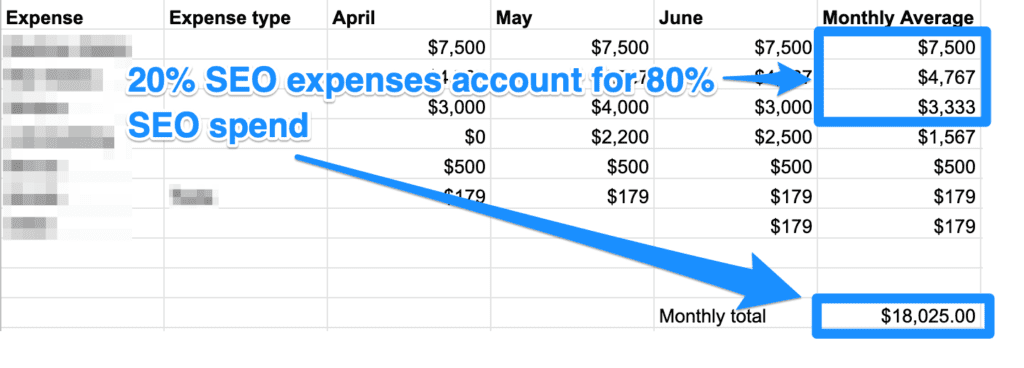Last updated on January 20, 2023
SaaS marketing leaders are surprisingly tight-lipped about how they manage their marketing budgets and their marketing budget templates.
When I got the opportunity to lead a marketing team and asked to create a marketing budget, I was expected to know everything. Instead, I had a gazillion questions in my head but no answers.
- WHERE do I find a SaaS marketing budget template to start?
- HOW do I customise a SaaS marketing budget template to my requirements?
- WHAT do I even need in a B2B SaaS marketing budget?
- How will a B2B SaaS marketing budget help me?
So I figured it out through trial and error over the years.
In this article, I shared how to plan your B2B SaaS marketing budget from the eyes of a first-timer.
Most SaaS marketing budget
templates are useless
I was clueless, so I searched on Google for “marketing budget templates“. Have you seen the SaaS marketing budget templates out there?! They look scary.

I also realised that searching in Google wasn’t helpful as copying someone else’s SaaS marketing budget template didn’t make sense. Here’s why:
- Every company has a different marketing playbook, strategy, team structure, revenue, budgets. For those reasons, someone else’s SaaS marketing budget template might not fit in my own use case.
- Most SaaS marketing budget templates look really complicated. Gazillion rows, columns, fancy formulas and lots of data to be input. But I didn’t know the baby steps – where do I even start in that sheet template? I wanted something easy to start with.
- I wanted to understand B2B SaaS marketing budgets from the foundation, from real world application and critical thinking. From a real requirement and problem solving perspective. I wanted to apply First Principles Thinking and find a solution for me.
Why do you need a B2B SaaS marketing budget?
There are THREE key reasons why a budget is essential for B2B SaaS marketing. It helps you:
Set Priorities
Without a budget, it can be difficult to set priorities for your marketing efforts. What should you spend your limited resources on? With a budget in place, you can allocate funds to the channels that are most likely to generate leads and close deals with the lowest risk and high return.
Let’s take an example. While analysing your SaaS marketing portfolio, you realise that:
- With Channel A, you’re spending 10x and getting 5x revenue.
- With Channel B, you’re spending 2x and getting 10x revenue.
Your resources are limited. To achieve the highest ROI results, should you continue going with the current budget distribution? Or should you reduce your budget on Channel A and move it to Channel B?
Stay Accountable
It’s easy to overspend on marketing when you don’t have a budget in place. A budget forces you to be more mindful of your spending and ensures that you’re getting the most bang for your buck.
By understanding your budget, you can make sure you’re channeling your resources into the areas that are most effective (lowest risk, highest return) and that will ultimately bring in the most revenue.
Measure ROI
A budget also allows you to track your marketing ROI and make changes to your strategy as needed. Without a budget, it can be difficult to know if your marketing efforts are actually paying off.
At the end of the day, it all comes down to money.
Views, backlinks, leads, customers, etc. are all well and good – but money is what really matters. How much revenue did we bring in to the business? That’s the only true indicator of the ROI of marketing.
How to create a SaaS marketing budget?
I started with defining the portfolio I was working with.
Here’s my biggest learning while planning a SaaS marketing budget:
You have to think like an investor and manage your marketing budget like an investment portfolio.

Instead of companies, your portfolio consists of channels. In order to be a great investment manager, you need to:
- Collect all your portfolio items in one place and define the portfolio you’re managing
- Analyse your portfolio (according to your company’s goals)
- Adjust budget by finding the channels in your portfolio with the lowest risk, highest return and moving investment focus on those portfolio items
Here’s a step by step process
#1 Understand your monthly spend (by looking at your expenses)
The first step is to understand where your marketing dollars are currently going. This means taking a close look at your team member salaries, software subscription costs, consultant fees, and any other expenses that fall under the marketing umbrella.
Start by understanding our current marketing spend by breaking down expenses in the last 1 year. To do this, you’ll need to gather all your data in one place and bucket them into categories.
I usually bucket all our expenses in these 8 categories:
- Salaries: This includes the salaries of all your team members in marketing, such as SEO managers, in-house content writer, and marketing generalist.
- Consultant/Agency fees: This is for any consultants/agency you hire to help with your marketing, such as SEO experts, link-building agencies or marketing advisors.
- Affiliate commissions: This is the commission you pay to affiliates for promoting your SaaS product.
- Writers: This is for any freelance writers you hire to create content for your blog.
- Ads: This includes all your advertising costs such as Google Ads, newsletter sponsorships etc.
- Tools: This is for any marketing-related tool subscriptions you use, such as email marketing, social media management or rank tracking.
- Learning stipend: This is for any training or courses your team takes to stay up-to-date on marketing trends.
- Miscellaneous: This is for anything else related to marketing that can’t be covered in above buckets.
Most important thing to remember is not to go overboard with tracking every little marketing expense and waste a lot of time on tracking that. You’re not an accountant, you’re a Head of Marketing!
The standard 80/20 rules applies with your marketing expenses: 20% expenses account for 80% of your marketing budget. It’s important to track those big marketing expenses well and get a directionally accurate idea of your overall marketing spend.
Here’s an example where 3/10 expenses accounted for majority of the marketing spend.

It’s important to track those big marketing expenses well and get a directionally accurate idea of your overall SaaS marketing spend.
By the end of this step, you’ll get a clear idea of how much you’re spending on marketing on average monthly.
#2 Add up the expenses based on each marketing channel
As you start to add up overall marketing expenses, it’s also important to add up expenses associated each marketing channel.
Let’s take the example of SEO as a marketing channel.
- First, you’ll want to consider the tools and resources you’ll need in order to execute your SEO strategy. For example, you’ll need to factor in the cost of your SEO tools (SEMrush, Surfer SEO etc.), as well as any consulting or writer fees you may incur.
- In addition, you’ll also want to consider the time investment required for each marketing activity. For example, you’ll want to include the SEO manager’s salary in your budget.
- Similarly, if you have someone who spends a portion of their time on SEO, you’ll want to factor in their time investment as well. For example, if you have a designer spending 40% of their week on SEO tasks, factor in their time investment as well (40% of their monthly salary)
Again with this, the standard 80/20 rule applies: 20% expenses account for 80% of your channel budget. For example, with SEO, your expenses like salaries, link-building agency and writer costs will probably be your largest expenses that have a big impact on how you spend on that channel. It’s important to keep a close eye on those.

The objective of this step is to have a clear understanding of your marketing spend within each channel. This will help you make informed decisions about where and how to allocate your resources.
#3 Find what % of total revenue is spent on marketing
Now that you know your total marketing spend segmented by channel, I recommend measuring what percentage of total revenue is being spent on marketing.
You can measure it by:
[($) Average monthly marketing expenses / ($) monthly recurring revenue] X 100% = (%) Percentage of total revenue spent on marketing
Next, I recommend comparing the percentage of revenue you spend on each marketing channel. You can measure it by:
[($) Average monthly marketing channel expenses / ($) monthly recurring revenue from marketing channel] X 100% = (%) Percentage of total revenue spent on a specific marketing channel
Lastly, I recommend tracking the payback period of each marketing channel. Payback period is the amount of time it takes for a SaaS company to earn back the money it has spent on acquiring a new customer. It’s important because it helps measure how quickly we can recoup its customer acquisition cost from that channel.
A shorter payback period is better because it means that a you can reinvest its profits back into acquiring new customers at a faster rate. Ideally, aim for CAC payback < 1 year.
You can measure it using this formula:
($) Total (average) monthly marketing channel expenses / ($) net new MRR from marketing channel] = (months) Payback period
By calculating these three metrics and analysing the data, you’ll get a greater visibility into the performance of your marketing portfolio and individual channels. Also, please remember that marketing attribution will never be perfect and 100% accurate! Instead, be okay with directional data and use your best judgement.
For example, this is what my analysis sheet looks like.

What I can see here is that I’m spending $25,000 per month on Channel A which has a payback period of 11 months, while I’m spending $ 8,333 per month on Channel B which has a payback period of 2.6 months.
It’s evidently clear after this analysis that a big opportunity lies within Channel B and I should spend more of my marketing budget on that channel. This helps inform how I should plan my B2B SaaS marketing budget.
I also recommend measuring and analysing your CAC and LTV for each channel to figure out how much to spend on each channel.
Also, if you don’t have historical data to refer back to, it’s fine to make assumptions. The important thing is that you create a framework for comparing different channels and their performance.
#4 Align with leadership on company’s revenue goals
Your yearly revenue goals will help you decide your marketing goals and vice versa. Your marketing forecast will help the company decide a revenue growth forecast and set a realistic revenue goal to achieve. It’s a two way street.
That’s why it’s important to align with your CEO and everyone else on the leadership team on the company’s revenue goals.
If the company’s revenue goals are aggressive (you’re at $5M ARR, company wants to double that in 1 year at the cost of temporary unprofitable growth), you’ll need to tweak your marketing portfolio strategy (like increasing the overall budget to hire more team members and investing in the channel with the highest ceiling for growth) to achieve those goals.
If the company’s revenue goals are modest (you’re at $5M ARR, company wants to get to $7M ARR in 1 year with very profitabl unit economics), maybe you’ll need to tweak your marketing portfolio strategy to focus more on which channels can get the most profitable growth.
Your revenue goals help you define your marketing goals, which eventually helps you define your marketing budget and marketing portfolio strategy.
#5 Define the actual numbers in the budget
Once you have analysed all this data, ask yourself this:
- Where will I need to invest in the coming year to get us to our annual revenue target?
- Where would my marketing budget and spend increase and where would it decrease?
- What are the lowest risk and highest return channels in my marketing portfolio?
The answers to these questions and the data will help you decide the final numbers of your marketing budget.
You’d want to spread your portfolio of bets using a 70-20-10 framework. 70% budget to core channels, 20% to emerging channels, 10% to Hail Marys as shared by David Fallarme (former Head of Marketing at Hubspot Asia).
I’ll also highly recommend you to watch our interview with Typeform & Hotjar’s former VP of Marketing about managing a marketing budget.
How much are other SaaS companies spending on marketing?
The benchmark is 10-40% of overall ARR. But every industry is different, every company is different and every growth stage is different. I’d recommend reading our research on how much other SaaS companies are spending on marketing.
Another GREAT resource is our interview with Todoist’s CMO.
Pssst… That’s where I come in!
My name is Madhav and I’ve helped multiple SaaS companies grow from $500k to $5M ARR.
Here’s what Bonsai‘s CEO said after working with me:
“Madhav took great ownership of Bonsai’s marketing from day 1. He ramped up quickly, kickstarted a lot of new initiatives, built out a great team of super-specialists and balanced our growing portfolio of marketing channels well. 3 things I love about him: he asks a lot of questions to uncover insights, he’s great at building repeatable play-books and processes and he’s always asking for feedback to improve himself and fill the gaps.
As part of our leadership team, he made some awesome contributions to our organization and I’d definitely recommend working with him!“
Here’s what Hubstaff‘s CEO said after working with me:
“Madhav was one of our first hires at Hubstaff & he’s been a huge part of our success early on. We worked together closely for 4 years. He’s a smart marketer who possesses high levels of integrity, autonomy, and self-motivation.
As a person, he’s easy going, reliable & honest. He proactively asks for feedback, takes ownership of his mistakes, and loves applying his lessons learned to get 10x better.
Madhav’s work at Hubstaff has been incredible to watch. He’s often shown his ability to take a broad company initiative and turn it into tactical plans that help achieve company goals. He’s a skilled written communicator, highly analytical & an excellent remote team manager. In fact, he actively contributed in hiring, coaching, managing & developing our marketing team.
If there’s ever a tiny, brief window where you have the opportunity to work with him, don’t miss it!”
If you need help with your marketing to grow your SaaS from $500k to $5M ARR, let’s chat!

